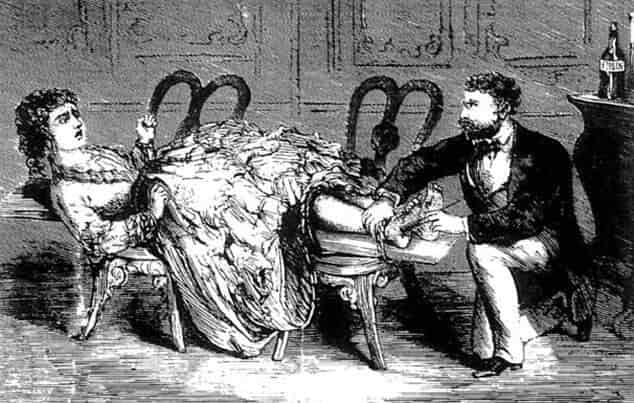The Strange History of Tickle Torture: A Punishment Through the Ages

Tickling is often seen as a fun and harmless activity. Many of us have laughed uncontrollably while being tickled by friends or family.
But throughout history, tickling has been used for a much darker purpose: as a method of torture. From ancient China to Nazi Germany, tickle torture has been used to punish, interrogate, or humiliate people in surprisingly cruel ways.
Why Does Tickling Work?
Tickling targets sensitive areas of the body, such as the feet, underarms, or sides. When tickled, most people laugh, squirm, and feel a strange mix of discomfort and helplessness. This reaction is why some cultures used tickling as a punishment. It can be a powerful way to immobilize someone without causing permanent physical harm.
The famous philosopher Aristotle believed that only humans could be ticklish because we have sensitive skin and can laugh. However, scientists later found that animals like chimpanzees, rats, and even fish can also react to tickling. Despite its playful appearance, tickling triggers intense sensations that can feel close to pain.
The Connection Between Pleasure And Pain
Philosophers and scientists have studied the strange link between tickling, pleasure, and pain for centuries. In the 1600s, the philosopher René Descartes wrote that tickling causes the body to respond as if it is in pain, even though it might feel pleasurable at first. He explained that we enjoy some sensations, like sadness or fear, when we know they can’t truly hurt us — just like being tickled.
But when used as a punishment, tickling goes beyond this line between pleasure and pain. It becomes a tool to humiliate and break someone’s will. This is why it became a method of torture in many cultures.
Tickle Torture in History
Ancient China: Gentle Yet Cruel
During the Han dynasty in China (206 BCE – 220 CE), tickling was used as a form of punishment. It was especially favored because it left no lasting injuries, making it a “clean” method of torture. Someone could be tickled until they confessed or complied, but they would physically recover quickly.
Japan: “Merciless Tickling”
In Japan, there was a form of tickle torture called *kusuguri-zeme*, which translates to “merciless tickling.” This method was part of a larger system of punishments for those who broke the law or dishonored their community. Like in China, it was seen as a way to punish without leaving visible scars.
Ancient Rome: Tickling With Goats
The Romans took tickle torture to another level. They would tie up prisoners and dip their feet in saltwater. Then, goats were brought in to lick the soles of the prisoners’ feet. At first, this might seem amusing, but the goats’ rough tongues would eventually irritate and break the skin. As the process continued, it became extremely painful. Historian Joost Meerloo described how the wounded feet would then be covered in salt again, repeating the cycle until the prisoner could no longer endure the pain.
The Victorian Era: Tickle Torture at Home
In the 19th century, tickling appeared in stories about domestic violence. One shocking account from 1869 told of a man, Michael Puckridge, who tied his wife to a board and tickled her feet as a “cure” for her varicose veins. Another fictional story described Pierrot the Clown, a character who tickled his wife to death. These tales reflect how tickling, even in private settings, could cross the line from playful to abusive.
Modern Instances of Tickle Torture
World War II: Nazi Interrogations
Even in the 20th century, tickle torture was used for cruel purposes. During World War II, a man named Josef Kohout, who survived a Nazi concentration camp, wrote about witnessing guards use tickling as a way to torment prisoners. He described how guards would tie up a prisoner and tickle him with feathers on sensitive parts of the body, like the feet and underarms. What started as laughter quickly turned into cries of pain.
Sibling Rivalries and Abuse
In many households, tickling is a common way for siblings to tease each other. However, experts warn that tickling can sometimes cross into abuse. In a study by family violence expert Vernon Wiehe, some adults recalled childhood experiences of being tickled until they vomited, urinated, or couldn’t breathe. For these victims, tickling was not fun but a traumatic experience.
Why Tickling Can Be Dangerous
Most people don’t think of tickling as harmful. However, prolonged tickling can cause serious physical and emotional damage. Extreme tickling can lead to:
– Asphyxiation (difficulty breathing)
– Stress injuries (like aneurysms)
– Emotional trauma
While it may not leave bruises, the effects of tickle torture can last long after the laughter has stopped.
Tickling in Art and Culture
Throughout history, tickling has also appeared in stories, plays, and art. Some historians believe that the recurring theme of tickle torture reflects deeper questions about human psychology and even sexuality. Why are people so fascinated by something that can cause both joy and suffering?
Conclusion: Tickling Is No Laughing Matter
While tickling is often seen as a harmless game, its history shows that it can be a powerful tool for control and punishment. From ancient China to modern homes, tickling has been used to dominate and humiliate. So the next time you laugh while being tickled, remember: for some, tickling was no joke.
FAQs About the History of Tickle Torture
1. What is tickle torture?
Tickle torture is the use of tickling to punish, interrogate, or dominate someone. While tickling is usually playful, it has been used throughout history as a method of torture to cause discomfort or humiliation.
2. Why was tickle torture used as punishment?
Tickle torture was often chosen because it leaves no lasting physical marks or injuries, making it a “clean” method of punishment. It also immobilizes the victim and causes significant discomfort, making it effective for interrogations or humiliations.
3. Which cultures used tickle torture?
Tickle torture has been used in various cultures, including:
- Ancient China during the Han dynasty for punishing offenders.
- Ancient Rome, where prisoners’ feet were licked by goats after being soaked in saltwater.
- Japan, where it was part of the kusuguri-zeme or “merciless tickling” punishments.
4. Can tickling be dangerous?
Yes, prolonged tickling can cause physical harm such as asphyxiation, stress-related injuries like aneurysms, and even emotional trauma. Despite its playful reputation, tickling can be distressing and harmful when taken to extremes.
5. Did the Nazis use tickle torture?
Yes, there are accounts from concentration camp survivors indicating that Nazis used tickle torture as a method of torment. Prisoners were tickled in sensitive areas, causing pain and humiliation.
6. Why do people laugh when they are tickled?
Laughter during tickling is an involuntary reflex triggered by nerve stimulation in sensitive areas. This response does not always mean the person is enjoying it; it can often indicate discomfort or distress.
7. How was tickle torture used in Ancient Rome?
In Ancient Rome, tickle torture involved tying prisoners up and soaking their feet in saltwater. Goats were then made to lick the soles of their feet, creating a cycle of irritation and pain as the rough tongues wore down the skin.
8. What is kusuguri-zeme?
Kusuguri-zeme is a Japanese term meaning “merciless tickling.” It was used as a form of private punishment in Japan to humiliate or control offenders.
9. Can tickling be considered abuse?
Yes, tickling can be abusive if it causes physical or emotional harm. Studies show that excessive tickling can lead to traumatic experiences, especially when used as a form of control or punishment.
10. Is tickling still used as torture today?
While there is no widespread evidence of tickle torture in modern legal systems, it can still occur in isolated cases, often in domestic settings or as a form of psychological abuse.
11. What did philosophers like Descartes think about tickling?
Philosopher René Descartes believed that tickling creates a sensation close to pain, which explains its effectiveness as a punishment. He studied the relationship between tickling, pleasure, and pain as part of human sensory experiences.
12. Why is tickling a recurring theme in art and culture?
Tickling appears in art, literature, and plays because it fascinates people with its mix of joy and discomfort. It reflects deeper questions about human psychology and the blurred lines between pleasure and pain.
13. Can animals be ticklish?
Yes, studies show that animals like chimpanzees and rats react to tickling. Even fish exhibit responses to certain types of stimulation, disproving Aristotle’s belief that only humans are ticklish.
14. How can tickling affect children?
Excessive tickling can lead to serious emotional and physical effects in children. It may cause vomiting, urination, or difficulty breathing, and in extreme cases, can result in lasting trauma.
